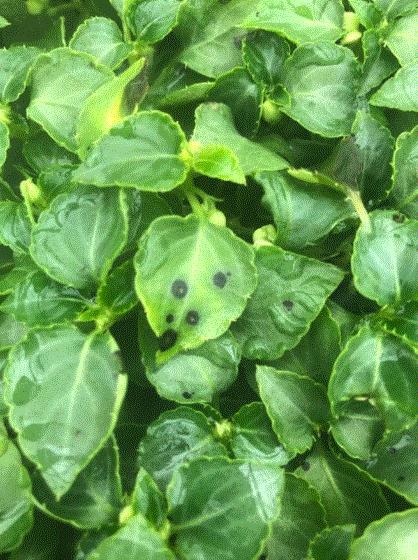Holding & Delaying Crops
It might seem early for this first item with everything in your greenhouse operating in high gear, but having a plan in place to hold or delay crops is something you can work on right now to avoid being caught off guard or scrambling to figure it all out if and when the time comes to slow things down.
We recorded this discussion four years ago in the early days of Tech On Demand, and I’m pretty sure I’ve shared it again around this time of year ever since. We did initially create this due to pandemic-related shipping delays, but the info is relevant any time you need to hold your crops.

IN THIS AUDIO DISCUSSION, I caught up with three experts covering a wide range of greenhouse crops from a technical and cultural perspective to learn strategies greenhouse professionals can use when product can’t be shipped on time. Which crops respond well to holding and delaying strategies, from cutting back and temperature manipulation, to chemicals and lighting? How can you best make those kinds of decisions? What data do we have to determine how to treat specific crops? Are there any that you absolutely should not hold in certain ways? We tackle all of this and much more for seed annuals, vegetative annuals and perennials. The goal was to keep annual and perennial crops alive and saleable longer.
And to help even more, check out the SORTABLE EXCEL FILE with holding strategies for key classes. Click the link and scroll down to “Holding and Delaying Crops.”

Koppert Corner: Hitchhiker’s Guide to Flowering Tropicals
Be on the lookout for unruly insect pests hitchhiking into your garden center on flowering tropicals such as hibiscus, mandevilla and gardenia. Left unaddressed, they’ll disfigure these high-value products and can leave a trail of unsellable plants, even before Mother’s Day arrives.
In a wholesale environment using chemical pesticides to manage these hitchhikers is common; however, in a retail environment we need to adjust strategies. Flowering tropicals already in the garden center place limits on available solutions.

Impact of spider mites on hibiscus.
Extended spring retail hours leave insecticides with a 12-hour restricted entry interval (REI) period off the table. Further, there’s a significant chance that unruly hitchhikers are resistant to chemical-based pesticides, so how to deal with these grifters?
Strong Retail Options
Removing chemical pesticides, we still have strong options to suppress pests. Our non-chemical pesticide toolbox now consists of soaps, oils, entomopathogenic nematodes, mycoinsecticides, insect growth regulators and biopesticides.
Haven’t yet moved incoming tropicals into the garden center? Taking time to quarantine incoming shipments and treat them with a series of three to four non-chemical pesticide applications within a two-week period. This cleans up incoming insect pests and significantly reduces the potential of a business-disrupting pest flare-up during peak spring retail sales weeks.
Expect insect pests to arrive on flowers, leaves, stems and in the root zone. Drench incoming tropicals with a tank mix of Capsanem (Steinernema carpocapsae) nematodes and a mycoinsecticide such as Isarid (Isaria fumosorosea, strain FE-9901) twice within one week of arrival to impact pupating insects in the root zone.
Complement root zone drenches with wet spray tank-mix applications of Isarid + EpiShield or Isarid + SuffOil-X to target adult and immature stages on the plant. After two drench and two spray applications within two weeks, these plants can be moved to retail.
When spraying pesticides with REIs is not possible, utilize EpiShield (0-hour REI) tank-mixed with Capsanem, applied as a spray, twice weekly to control insect pests. Continue weekly retail spray applications thereafter.
Want to learn more about managing insects in your garden center? Reach out to a Koppert Technical Consultant!

Nick’s Tip of the Week: Is it IDM?
Each week, I’ll work with my buddy Nick Flax, a technical services expert at Ball, to share a concern that’s come up during one of his numerous calls with growers across North America. This week, he’s been swamped with calls, but he took some time to think back to a grower he worked with in the past to identify and manage spots on a spring impatiens crop during cold, wet early days in spring.
PROBLEM: Many Northern growers have had a few warm days, but for the most part you have been battling cool, wet, cloudy weather, all while plug trays are still coming in or crops have been in baskets and/or flats for a few weeks—not to mention your greenhouses are packed to the gills! In a past season with weather like this, I talked to a grower with a large crop of Impatiens Downy Mildew (IDM)-resistant Impatiens walleriana. First off, kudos to this operation for moving into these new highly-resistant genetics! However, they were very concerned when they saw dark discolored spots popping up on some of their incoming plugs, and they contacted me for help. So, what’s happening in the picture here?

NICK'S TIP: Good news for anyone else who is seeing this on their impatiens – it is NOT IDM. In this case, Septoria leaf spot (another lovely fungal disease) is the culprit.
Symptoms are pretty distinctive, so if you see tannish-gray leaf spots with dark purple or even blackish-looking borders, you’ve probably got Septoria. Cultural management helps reduce infection significantly, so avoid keeping foliage wet for long periods (this will also help combat other leaf wetness-related issues, including IDM), increase air flow in your greenhouse, and space out plants wherever possible.
Chemical control can be achieved using a broad range of biologicals and conventional chemistries, and many chemistries labeled for controlling fungal leaf spot diseases fall into this category, including copper-based compounds, chlorothalonil, thiophanate methyl and mancozeb, to name a few. As a reminder, always check the label before applying!

The Latest on Thrips parvispinus
Here’s a Thrips parvispinus update report from Sarah Jandricic, Greenhouse Floriculture IPM Specialist at OMAFRA—based on a recent presentation by Dr. Alexandra Revynthi’s lab at University of Florida. Both of these researchers and their organizations have been deeply involved in studying, tracking and documenting Thrips parvispinus for the past couple of seasons and have created excellent resources to assist growers scouting for and managing this specific pest. They’re my go-tos when I want to report the latest findings.

Update from the webinar: Thrips parvispinus is no longer a regulated pest for nurseries in Florida. Current quarantine orders will only target stock dealers with large thrips populations (not nurseries themselves).
What this means for you (growers): The good news, according to Sarah's report, is that URCs may now have lower thrips numbers on them, if large Parvi populations are reported at a facility. We’ve already been seeing reductions since two of the main suppliers of mandevilla cuttings have screened their production facilities. However, finished products from Florida nurseries may have high numbers of Parvi on them, as they are no longer regulated.
Read the FULL REPORT HERE.

$50,000+ in Scholarships Available!
Now’s the time for students pursuing careers in the green industry to submit applications to the Horticultural Research Institute (HRI) for one of 12 scholarships, which range from $1,000 to $5,000. Applicants will also be considered for the Sidney B. Meadows Endowment Fund Scholarship (12 additional $2,000 awards). From my count, HRI currently offers at least 10 different scholarships, with more coming in the future.

As a parent of a high school junior who’s currently whittling down her list of potential schools (and giving me my first taste of current college tuitions), I can attest to how much of a difference these scholarships can make for an aspiring hort student. If you know someone who qualifies or if you have connections to local schools, please pass along this opportunity!
Learn more about the HRI SCHOLARSHIP PROGRAM HERE—and access the online application system. The deadline to apply is May 31.
Finish Line … It’s Kids Gardening Month!
Did you know April is Kids Garden Month? I’m sure all of you will agree that exposing kids to the wonders of nature that can be experienced and learned in the garden is critical—and even an antidote to today’s digital society and all that comes with it. That’s a discussion for a different day, but let’s just say there’s a ton of value in kids getting their hands dirty!

Kids Garden Month is an annual celebration of kids in the garden led by KidsGardening.org. Each April, KidsGardening.org hosts a contest to celebrate kid gardeners and the many positive benefits gardening has on kids and their communities. This year’s challenge includes ten garden-related activities for kids to complete—everything from drawing a garden comic, planting seeds in a cup, learning about soil, designing merch and more.
Your greenhouse can support this effort by sharing the 2025 KIDS GARDEN MONTH CHALLENGE with your community network, on your social channels and even with your employees! At that link, you’ll find social media-ready images and content to make it really easy to get the word out.
KidsGardening.org is a non-profit that I’m very passionate about (so much so, I'm on the Board) that does its part to encourage students, teachers, caregivers and anyone involved in the life of a child to explore the garden—offering resources and community to support these efforts. KidsGardening also distributes grants for garden installations and much more. I’d be remiss if I didn’t also include a link to DONATE. Trust me, this is a good cause.
Until next week, stay warm and keep a close eye on those crops. Speaking of which … I spoke with Dr. Raymond Cloyd (entomology prof at Kansas State) this week and he mentioned that this time of year, when plants are sitting in greenhouses waiting to be shipped out, pests can get out of hand. Watch for a Tech On Demand podcast with Dr. Cloyd that will drop early next week.




Please feel free to send your comments, constructive criticism and topic ideas to me at bcalkins@ballhort.com.

Bill Calkins
Editor - Tech On Demand
This email was received by you and 25,624 other fine subscribers!
If you're interested in advertising in Tech On Demand, contact Kim Brown ASAP and she'll hook you up.